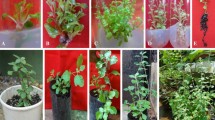Abstract
In vitro propagation of Atropa baetica was established employing axillary buds. Single buds were cultured through a multiple shoot induction phase, rooting phase, and then followed by acclimatization in soil. For multiple shoot induction, Murashige and Skoog (MS) medium with 3% sucrose, supplemented with either 0.75 or 1.25 mg l-1 of BAP provided the best results with an average of 5.6 shoots per explant after 31 days of culture. Similar results were obtained with higher BAP concentrations (1.75–2.0 mg l-1); however, these media had a negative effect on the subsequent root induction due to residual BAP effect. Medium containing only 0.25 mg l-1 of BAP induced a significantly lower number of shoots. Root induction occurred spontaneously after transferring the shoots onto MS medium lacking any plant growth regulator. Moreover, root induction also occurred on media supplemented with 0.125 and 0.25 mg l-1 of NAA. On these two rooting media, this response was more prominent and with a higher number of roots per explant. Nevertheless, after 28 days on root induction medium, the number of rooted plantlets was similar on the three media. Acclimatization of plantlets in soil was very successful (95.52%). However, all plantlets which died during acclimatization were rooted on medium containing 0.25 mg l-1 NAA suggesting a negative carry over effect of this medium upon plantlet survival, irrespective of the initial BAP treatment used. On the other hand, karyological studies showed no variation in the number of chromosome (2n=72) in root tips of the plantlets produced.
Similar content being viewed by others
References
Aparicio, A., 1993. Planes de recuperación de especies vegetales amenazadas en el parque natural de la sierra de Grazalema (Cádiz-Málaga). Acta Bot Malacitana, 18: 199–221.
Bajaj, Y.P.S. & L.K. Simola, 1991. I Atropa belladonna L.: In vitro culture, regeneration of plants, cryopreservation, and the production of tropane alkaloid. In: Y.P.S. Bajaj (Ed.), Biotechnology in Agriculture and Forestry Vol 15. Medicinal and aromatic plants III, pp. 1–23. Springer-Verlag, Berlin.
Benjamin, B.D., G. Roja, M.R. Heble & M.S. Chadha, 1987. Multiple shoot cultures of Atropa belladonna: effect of physicochemical factors on growth and alkaloid formation. J Plant Physiol 129: 129–135.
Bramwell, D., 1990. The rôle of in vitro cultivation in the conservation of endangered species. In: J.E. Hernandez Bermudez, M. Clemente & V. Heywood (Eds.), Proceedings of the Intl. Conference on Conservation techniques in botanic gardens, pp. 3–15, Cordoba, Spain. Koenigstein: Koeltz Scientific Books.
Cantos, M., J. Linñan, F. Pérez-Camacho & A. Troncoso, 1993. Obtención de plantas selectas de vid, variedad Zalema, libres de la virosis entrenudo corto. In: II Congreso Ibérico de Ciencias Hortícolas, vol. 1. pp. 705–709, Zaragoza, Spain.
Christen, P., K. Aoki & K. Shimomura, 1992. Characteristics of growth and tropane alkaloid production in Hyoscyamus albus hairy roots transformed with Agrobacterium rhizogenes A4. Plant Cell Rep 11: 597–600.
Drew, R.A., M.K. Smith & D.W. Anderson, 1992. Field evaluation of micropropagated bananas derived from plants containing Banana Bunchy-Top Virus. Plant Cell Tiss Org Cult 28: 203–205.
Fay, M.F., 1992. Conservation of rare and endangered plants using in vitro methods. J In vitro Cellular Develop. Biology-Plant 28: 1–4.
Firn, R.D., 1986. Growth substance sensitivity: The need for clearer ideas, precise terms and purposeful experiments. Physiol Plant 67: 267–272.
Flick, C.E., D.A. Evans & W.R. Sharp, 1983. Organogenesis In: D.A. Evans, W.R. Sharp, P.V. Ammirato, Y. Yamada (Eds.) Handbook of Plant Cell Culture Vol. 1, pp. 13–81. Macmillan Publishing Co. New York.
Green, C.E. & C.A. Rhodes, 1982. Plant regeneration in tissue cultures of maize. In: W.F. Sheridan (Ed.), Maize for Biological Research, pp. 367–372, University of North Dakota Press, USA.
Hernández-Bermejo, J.C. & M. Clemente-Muñoz, 1994. Protección de la Flora de Andalucia, Junta de Andalucia, C.C.M.A. and A.M.A., Spain.
Herrera, C.M., 1987. Distribución, ecología y conservación de Atropa baetica Willk. (Solanaceae) en la Sierra de Cazorla. An J Bot Madrid, 43: 386–398.
Hilton, M.G. & M.J.C. Rhodes, 1993. Factors affecting the growth and hyoscyamine production during batch culture of transformed roots of Datura stramonium. Planta Med 59: 340–344.
Kato, R., H. Kamada & M. Asashima, 1989. Effects of high and very low magnetic fields on the growth of hairy roots of Daucus carota and Atropa belladonna. Plant Cell Physiol 30: 605–608.
Malamug, J.J.K., H. Inden & T. Asahira, 1991. Plantlet regeneration and propagation from ginger callus. Sci Hort 48: 89–97.
Meins, F., 1983. Heritable variation in plant cell culture. Ann Rev Plant Physiol 34: 327–346.
Morte, M.A., M. Honrubia & A. Piqueras, 1992. Micropropagation of Tetraclinis articulata (Vahl) Masters (Crupessaceae). Plant Cell Tiss Org Cult 28: 231–233.
Murashige, T. & F. Skoog, 1962. A revised medium for rapid growth and bio-assays with tobacco tissue cultures. Physiol Plant 15: 473–497.
Sharp, J.M. & P.M. Doran, 1990. Characteristics of growth and tropane alkaloid synthesis in Atropa belladonna roots transformed by Agrobacterium rhizogenes. J Biotechn 16: 171–186.
Silvestre, S., 1986. Números cromósomicos para la flora española, 435–496. Lagascalia 14(2): 273–304.
Snow R., 1963. Alcoholic hydrochloric acid-carmine as a stain for chromosomes in squash preparations. Stain Techn 8: 9–13.
Trewavas, A.J., 1981. How do plant growth substances work?. Plant Cell and Environ 4: 203–228.
Trewavas, A.J., 1992. How do plant growth substances work? II. Plant Cell Environ 14: 1–12.
Valdes, B., S. Talavera, E. Fernandez-Galiano, 1987. Solanaceae. In: Flora Vascular de Andalucía Occidental, pp. 351–362, Ketres Editorial S.A., Barcelona, Spain.
Vieitez, A.M., M.C. Sanchez, J.B. Amomarco & A. Ballester, 1994. Forced flushing of branch segments as a method for obtaining reactive explants of mature Quercus robur trees for micropropagation. Plant Cell Tiss Org Cult 37: 287–295.
Zenkteler, M., 1971. Development of new plants from leaves and roots of Atropa belladonna L. in the in vitro culture. Acta Soc Bot Pol 40: 305–313.
Author information
Authors and Affiliations
Rights and permissions
About this article
Cite this article
Zarate, R., Cantos, M. & Troncoso, A. Induction and development of adventitious shoots of Atropa baetica as a means of propagation. Euphytica 94, 361–366 (1997). https://doi.org/10.1023/A:1002953929890
Issue Date:
DOI: https://doi.org/10.1023/A:1002953929890




